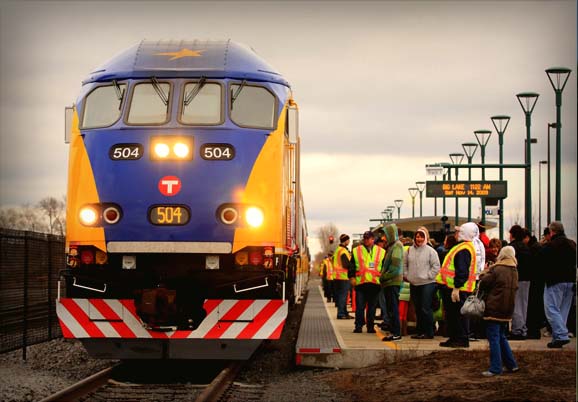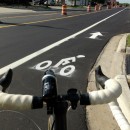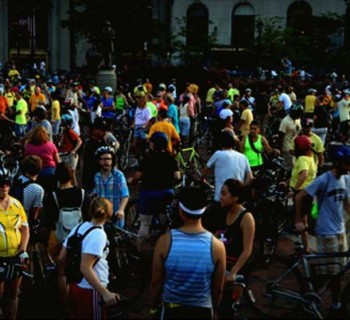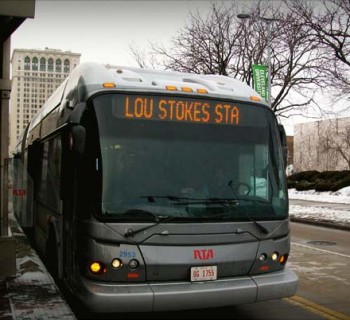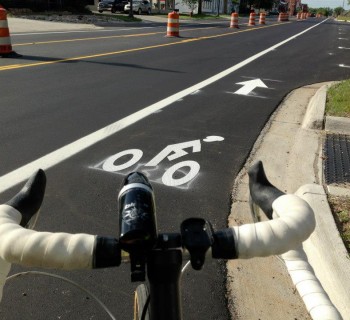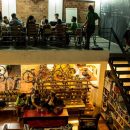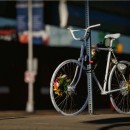MINNEAPOLIS—As Complete Streets policies continue to gain traction in communities across the state, it’s a good idea to learn from successful transit and non-motorized systems across the country. Here are few examples of successful multi-modal metropolitan area transportation systems that we can use as models.
One city with exemplary multi-modal transportation is Minneapolis. That city’s experience may be particularly instructive for us, as it shares similar post-industrial challenges with Michigan locales like Detroit and Flint.
All rails, trains and buses offer bike racks, and many are wheel chair accessible.
As with many urban centers, Minneapolis began to experience a major population decline in the 1950s. Residents left in droves, a trend that was exacerbated by massive freeway expansion. In recent decades, the city has seen a revival, largely through utilizing their riverfront area. There, city planners have created amenities such as mixed use buildings and bike paths, which attracted residents and developers. Where people come, jobs come- and for jobs to be accessible, viable transportation is vital.
Public transportation is provided mainly through the Metro Transit--the transit system for the Minneapolis-Saint Paul region. It includes light rail, commuter rail and 123 bus routes. All rails, trains and buses offer bike racks, and many are wheel chair accessible.
Their 12 mile light-rail, Blue Line, makes 19 stops, including ones in downtown Minneapolis, the Minneapolis-St. Paul Airport and the Mall of America. The commuter rail is called the Northstar, which covers a 40-mile stretch from Minneapolis to Big Lake in approximately 50 minutes.
By comparison, a similar rail in Detroit would stretch from Hart Plaza on the Detroit Riverfront almost to Holly in northwest Oakland County. The Minneapolis rail provides transit for events such as Twins baseball games and festivals.
What’s more, the Metro Transit has an expansive system of traditional buses. They are currently in the process of switching their buses to gas-electric hybrids; they have 97 hybrid vehicles to date.
Another excellent model for Michigan is the Bus Rapid Transit system in Cleveland. This is particularly relevant to Grand Rapids, where the Grand Rapids SilverLine Bus Rapid Transit that will be up and running in August 2014 as Michigan’s first BRT line.
The SilverLine will run through 33 stations including the cities of Grand Rapids, Kentwood and Wyoming. Using Cleveland as a model makes sense – the Institute for Transportation and Development Policy ranks the Cleveland Health Line as the highest scoring BRT system in the country.
The Cleveland Health Line runs about seven miles through Downtown Cleveland, connecting many of the city’s main attractions. The BRT is only a portion of that city’s transit system, which is run by their Greater Cleveland Regional Transit Authority, recognized as the American Public Transit Association’s best transit system in 2007. Along with various bus routes, they offer four rail lines that go through the city.
In terms of model non-motorized infrastructure that Michigan regions might emulate, Eugene, Oregon has done it right. Roughly the size of Ann Arbor, Eugene has a mass transit system that operates almost 90 buses in peak hours, and ranks number six on Bicycling.com’s most bike-friendly cities in America. They state that, “Ample bike parking, lit bike paths and the Smart Ways to School program are just three of Eugene’s cycling-friendly characteristics.”
Eugene’s bike network includes 42 miles of shared-use paths and 81 miles of on-road bike lanes. The University of Oregon, in Eugene, is one of the League of American Bicyclists most bike friendly universities. Michigan State University, Michigan Technological University, University of Michigan – Ann Arbor and University of Michigan – Flint also ranks on the list!
Eugene also is a leader in motorized transit. The EMX Bus Rapid Transit system began service in 2007. It is run by the Lane Transit District (LTD), which prides itself on community engagement throughout the process of planning and designing the BRT system. This is not unlike the Woodward Visioning sessions that occurred for the Woodward Corridor Complete Streets policy.
In Michigan, we have reason to be optimistic about our transportation future. We have a growing coalition of partners – many of them nontraditional allies – who are pushing Michigan in the right direction.
With Grand Rapid’s SilverLine, the formation of a Southeast Michigan Regional Transit Authority and Michigan’s first bike-share program on track to begin as soon as this fall (Woodhouse, 2013), a more cohesive transportation future is on the horizon.
That’s all good news. And the best news may be that we don’t have to guess, or go it alone. We have plenty of good models that have shown us how to do it right!
Written by Kajal Ravani, Trans4M fellow


